Story Highlights
- Unemployment continues slide to 5.8%
- Hispanics make biggest gains
- 2014 workforce participation rate remains below previous years'
WASHINGTON, D.C. -- The U.S. Payroll to Population employment rate (P2P), as measured by Gallup, was 44.3% in December, statistically similar to the 44.2% measured in November. The percentage of Americans employed full time for an employer in 2014 did not show a steep end-of-year decline as it did in 2012 and 2013, offering hope that the P2P metric may strengthen more in the new year.
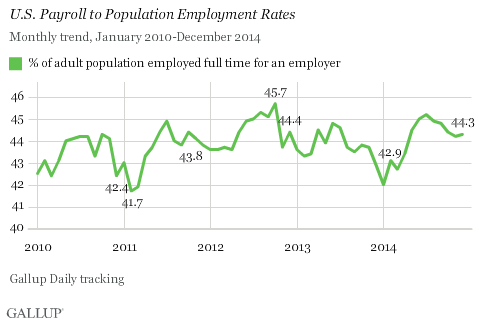
Gallup's P2P metric tracks the percentage of the U.S. adult population aged 18 and older who are employed by an employer for at least 30 hours per week. The latest results are based on Gallup Daily tracking interviews with 26,352 Americans, conducted Dec. 1-30 by landline telephone and cellphone. Gallup does not count adults who are self-employed, work fewer than 30 hours per week, who are unemployed or are out of the workforce as payroll-employed in the P2P metric.
P2P is not seasonally adjusted. However, because of seasonal fluctuations, year-over-year comparisons are helpful in evaluating whether monthly changes are attributable to seasonal hiring patterns or true growth (or deterioration) in the percentage of people working full time for an employer. The P2P rate in December 2014 is up from the rate in December 2013 (42.9%), and similar to the P2P rate recorded in December 2012 (44.4%).
Workforce Participation at 66.3%
Workforce participation among U.S. adults dipped slightly from 66.9% in November to 66.3% in December. Workforce participation measures the percentage of adults aged 18 and older who are working, or who are not working but are actively looking for work and are available for employment.

Workforce participation generally falls in the fourth quarter as retirements and layoffs are often pegged to the end of the year. The workforce participation rate has ranged narrowly between lows of 65.8% and highs of 68.5% since January 2010, but the 66.3% in December is among the lowest figures recorded in that time span. Workforce participation since mid-2013 has most often registered below 67%, whereas in prior years it was typically higher than that. This pattern reflects both a growing retiree population and declining participation among those still in their prime working years.
Unemployment Slides to 5.8%, Underemployment Steady
Gallup's U.S. unemployment rate represents the percentage of adults in the workforce who did not have any paid work in the past seven days, for an employer or themselves, and who were actively looking for and available to work. Gallup's unadjusted U.S. unemployment rate fell to 5.8% in December, continuing a relatively steady decline over the past 12 months, and reaching a new low in Gallup's five-year trend.
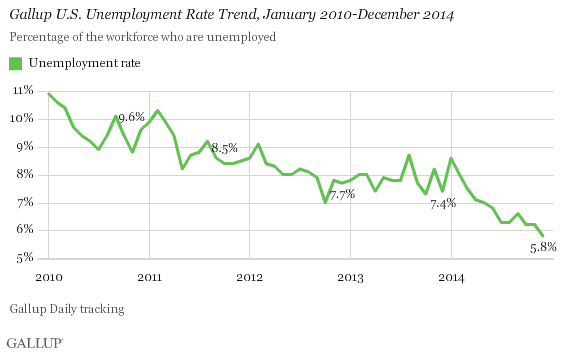
Unlike Gallup's P2P rate, which is a percentage of the total population, traditional employment metrics -- such as the unemployment rates Gallup and the U.S. Bureau of Labor Statistics (BLS) report -- are based on the percentage of the workforce. While both Gallup and BLS data are based on robust surveys, the two have important methodological differences. Additionally, the primary unemployment rate released by the BLS each month is seasonally adjusted. Although Gallup's employment numbers highly relate to BLS rates, Gallup's numbers tend to have more month-to-month variability, and the unemployment rate that the BLS reports each month does not always track precisely with the Gallup estimate.
Gallup's measure of underemployment in December is 15.1%, the same level registered in November, but still lower than what Gallup has measured in prior years. Gallup's U.S. underemployment rate combines the percentage of adults in the workforce who are unemployed (5.8%) and those who are working part time but desire full-time work (9.3%). While Gallup's measure of unemployment fell slightly in December from November, the percentage working part time but who want full-time work rose the same amount, leaving the combined underemployment rate the same.
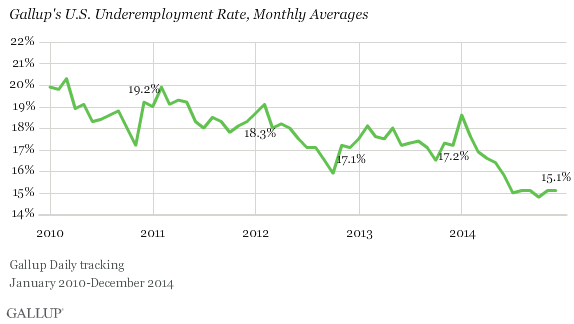
Hispanic Unemployment Rate Falls Six Points in 2014
Unemployment fell among Americans in most racial and ethnic groups over the course of 2014 (those of Asian descent were the sole exception), but it fell most among Hispanics. While white unemployment fell from 6.9% in January 2014 to 4.8% in December and black unemployment fell from 12.2% to 9.6%, unemployment among Hispanics fell from 13.1% in January to 7.3% in December 2014.
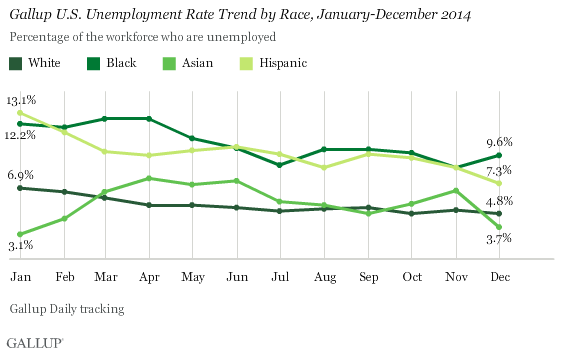
As a result of these changes in the unemployment rates, Hispanics made up 20.4% of all unemployed U.S. adults in December, down from 24.7% in January. This drop in Hispanic unemployment has been matched by a similar rise in P2P among Hispanics, from 44.3% in January to 49.7% in December -- the highest among any ethnic category in the U.S.
Bottom Line
Employment growth has been stronger in the past 12 months than in any year since Gallup began tracking these metrics in January 2010. P2P ended the year a point and a half higher than December 2013, the best performance of any year since 2010. Similarly, unemployment fell by a point and a half, the best performance since 2011. This improvement was shared across all demographics.
However, while workforce participation was stronger in 2014 than 2013, this figure has yet to recover most of the ground lost in the past few years. It remains to be seen whether hoped-for continued strength in 2015 can bring back discouraged workers or if a growing retiree population will drive this figure down even further.
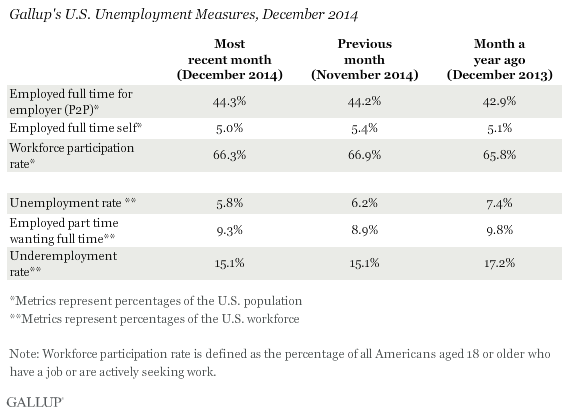
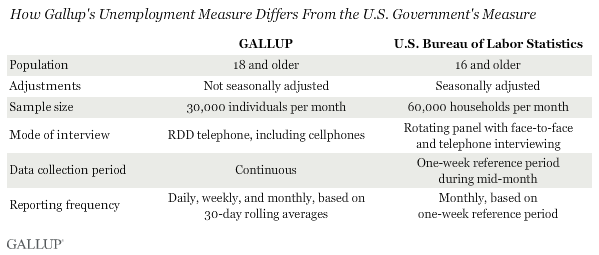
Gallup.com reports results from these indexes in daily, weekly, and monthly averages and in Gallup.com stories. Complete trend data are always available to view and export in the following charts:
Daily: Employment, Economic Confidence and Job Creation, Consumer Spending
Weekly: Employment, Economic Confidence, Job Creation, Consumer Spending
Read more about Gallup's economic measures.
View our economic release schedule.
Survey Methods
Results for this Gallup poll are based on telephone interviews conducted Dec. 1-30, 2014, on the Gallup U.S. Daily survey, with a random sample of 26,352 adults, aged 18 and older, living in all 50 U.S. states and the District of Columbia. For results based on the total sample of national adults, the margin of sampling error is ±1 percentage points at the 95% confidence level. All reported margins of sampling error include computed design effects for weighting.
Each sample of national adults includes a minimum quota of 50% cellphone respondents and 50% landline respondents, with additional minimum quotas by time zone within region. Landline and cellular telephone numbers are selected using random-digit-dial methods.
Learn more about how the Gallup U.S. Daily works.

